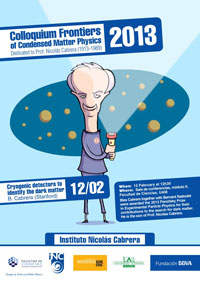Colloquiums INC 2015
 “Majorana braiding in superconductors: How to operate on a Zen Particle”
“Majorana braiding in superconductors: How to operate on a Zen Particle”
Carlo Beenakker; Leiden University; Lorentz Institute for theoretical physics
05 November
Sala de conferencias, módulo 0 Facultad de Ciencias, UAM.
Among the many exotic properties of topological superconductors, the prediction that they can host Majoranas stands out both for its fundamental interest and for possible applications in topological quantum computing. To exchange (braid) pairs of Majoranas is the heroic experiment, since it would identify them as a fundamentally newtype of quasiparticles with non-Abelian statistics. The road towards this goal has several milestones, starting from the detection of the zero-mode itself, on which the present generation of experiments is focused. In this talk we look ahead towards the next milestones: the construction of a qubit out of Majoranas, the measurement of its coherence times, and finally the braiding experiment to demonstrate its non-Abelian nature. The key problem that we address is how to operate on a cipher with zero charge, zero spin, zero energy, and zero mass — a “Zen particle”.
 “Exploring Flatland with cold atomic gases”
“Exploring Flatland with cold atomic gases”
Jean Dalibard; Collège de France; Laboratoire Kastler Brossel
19 October
Sala de conferencias, módulo 0 Facultad de Ciencias, UAM.
In his famous novel “Flatland” published in 1884, the English writer Edwin Abbott imagined a social life in a two-dimensional world. With a very original use of geometrical notions, E. Abbott produced a unique satire of his own society. Long after Abbott’s visionary allegory, microscopic physics has provided a practical path for the exploration of low-dimensional worlds.
With the realization of quantum wells for example, it has been possible to produce two-dimensional gases of electrons. The properties of these fluids dramatically differ from the standard three-dimensional case, and some of them are still lacking a full understanding.
During the last decade, a novel environment has been developed for the study of low-dimensional phenomena. It consists of cold atomic gases confined in laser traps, which can be shaped in arbitrary forms such as disks or annuli, in which permanent currents can be established. The talk will discuss some aspects of this research and explain how artificial magnetism can be implemented on these gases, raising the possibility to generate topological states of matter analogous to those appearing in Quantum Hall physics
 Superconductors : the Magic and the Mystery
Superconductors : the Magic and the Mystery
Louis Taillefer, Sherbrooke University, Canadian Institute for Advanced Research
16 March
Sala de conferencias módulo 00, Facultad de Ciencias.
Abstract:
Superconductivity is a magical property of matter, whereby electrons enter spontaneously into a macroscopic quantum dance in which electricity flows perfectly. Were this state sustainable at room temperature, our technological world would be profoundly transformed. The most promising materials are the copper oxides that remain superconducting halfway to room temperature. But the long-standing mystery of what binds electrons into pairs to form superconductivity has prevented scientists from understanding how this maximal temperature might be raised.
In my talk, I will discuss some of the magic of superconductors, properties harnessed to image brains in hospitals, whiz subatomic particles around at CERN, and levitate trains in Japan. I will also describe some recent advances in research that have shed new light on the mystery. In particular, I will discuss the role of charge-density-wave modulations that have recently been discovered to coexist and compete with superconductivity.
This is a story of electrons and scientists, featuring very low temperatures, huge magnetic fields, high pressures, pristine crystals, powerful microscopes, and the quantum world.
 Material Desingn and Strongly Correlated Electron Systems
Material Desingn and Strongly Correlated Electron Systems
Gabriel Kotliar (Rutgers University)
16 January
Sala de conferencias módulo 00, Facultad de Ciencias.
Abstrac:
Our understanding of simple solids, is firmly grounded on the Fermi liquid concept and powerful computational techniques built around the density functional theory. These ideas form the basis of our “standard model” of solid state physics and have provided us with an accurate description of many materials of great technological significance.
Correlated electron systems are materials for which the the standard model of solid state physics fails dramatically. The best known example being the copper oxide high temperature superconductors. Correlated electron materials continue to be discovered accidentally and surprise us with their exceptional physical properties and their potential for new applications. The most recent example is provided by the iron arsenide based high temperature superconductors.
From a theoretical perspective describing strongly correlated electron systems pose one of the most difficult non-perturbative challenges in physics. In this colloquium I will give an elementary introduction to the field of strongly correlated electron materials and Dynamical Mean Field Theory (DMFT) a non perturbative method which provides a zeroth order picture of the strong correlation phenomena in close analogy with the Weiss mean field theory in statistical mechanics. Applications materials containing f and d electrons will be presented to show how the anomalous properties of correlated materials emerge from their atomic constituents.
I will conclude with an outlook of the challenges ahead and the perspectives for a rational material design.






